Sustainability Attributes in Real Estate Development: Private Perspectives on Advancing Energy Regulation in a Liberalized Market
Abstract
:1. Introduction
1.1. Real Estate Attributes as a Value-Added Strategy
1.2. The Promotion of Energy Efficiency Housing in Chile
2. Theoretical Framework
2.1. Understanding the Concept of Real Estate Attributes
2.2. The Configuration of Real Estate Prices
3. Methodology
4. The Cross-Validation of Attributes in Supply and Demand in Two Real Estate Microsectors
- Consolidated attributes (high presence in supply and important in demand)
- Emerging attributes (low presence in supply and important in demand)
- Disposable attributes (low presence in supply and little importance in demand)
- Uncertain attributes (high presence in supply and little importance in demand)
5. The Evolution of Sustainability Attributes in Real Estate Promotion
6. Conclusions
Acknowledgments
Author Contributions
Conflicts of Interest
References
- Hough, D.E.; Kratz, C.G. Can “good” architecture meet the market test? J. Urban Econ. 1983, 14, 40–54. [Google Scholar] [CrossRef]
- Vandell, K.D.; Lane, J.S. The economics of architecture and urban design: Some preliminary findings. Real Estate Econ. 1989, 17, 235–260. [Google Scholar] [CrossRef]
- Plaut, S.; Uzulena, E. Architectural design and the value of housing in Riga, Latvia. Int. Real Estate Rev. 2006, 9, 112–131. [Google Scholar]
- Macmillan, S. Added value of good design. Build. Res. Inf. 2006, 34, 257–271. [Google Scholar] [CrossRef]
- The Royal Institute of British Architects (RIBA). Good Design—It All Adds Up; The Royal Institute of British Architects: London, UK, 2011. [Google Scholar]
- Pulselli, R.M.; Simoncini, E.; Pulselli, F.M.; Bastianoni, S. Emergy analysis of building manufacturing, maintenance and use: Em-building indices to evaluate housing sustainability. Energy Build. 2007, 39, 620–628. [Google Scholar] [CrossRef]
- Chartered Association of Building Engineers (CABE). The Value of Housing Design and Layout; Chartered Association of Building Engineers: London, UK, 2003. [Google Scholar]
- Lancaster, K.J. A New Approach to Consumer Theory. J. Political Econ. 1966, 74, 132. [Google Scholar] [CrossRef]
- Rosen, S. Hedonic Prices and Implicit Markets: Product Differentiation in Pure Competition. J. Political Econ. 1974, 82, 34–55. [Google Scholar] [CrossRef]
- Jansen, S. Chapter 5. The Multi-attribute Utility Method. In The Measurement and Analysis of Housing Preference and Choice; Jansen, S., Coolen, H., Goetgeluk, R., Eds.; Springer: Dordrecht, The Netherlands, 2011; pp. 101–125. ISBN 978-90-481-8893-2. [Google Scholar] [CrossRef]
- Marmolejo, C.; Echavarría, J.C.; Biere, R. El valor de la centralidad: Un análisis para la Barcelona Metropolitana. Archit. City Environ. 2016, 11, 95–112. [Google Scholar] [CrossRef] [Green Version]
- Encinas, F.; Tironi, M. Singularizando estilos de vida. Fabricación de imaginarios en condominios cerrados en Santiago. Rev. ARQ 2016, 56–67. [Google Scholar] [CrossRef]
- Keeping, M. What about Demand? Do Investors Want “Sustainable Buildings”? RICS Research Foundation: London, UK, 2000. [Google Scholar]
- Corporación de Desarrollo Tecnológico (CDT). Guía Desarrollo Sustentable de Proyectos Inmobiliarios; Corporación de Desarrollo Tecnológico, Cámara Chilena de la Construcción: Santiago, Chile, 2015. [Google Scholar]
- Hwang, S.; Thill, J.-C. Influence of Job Accessibility on Housing Market Processes: Study of Spatial Stationarity in the Buffalo and Seattle Metropolitan Areas. In Geospatial Analysis and Modelling of Urban Structure and Dynamics; Jiang, B., Yao, X., Eds.; Springer: Dordrecht, The Netherlands, 2010; pp. 373–391. [Google Scholar]
- Bourdieu, P. The Social Structures of the Economy, 1st ed.; Polity Press: Cambridge, UK, 2005. [Google Scholar]
- Instituto Nacional de Estadísticas País y Regiones Por Áreas Urbana-Rural: Actualización Población 2002–2012 y Proyecciones 2013–2020. Available online: http://www.ine.cl/estadisticas/demograficas-y-vitales (accessed on 9 October 2017).
- CChC Mercado Inmobiliario-Oferta Nacional y Gran Santiago. Available online: http://www.cchc.cl/centro-de-informacion/indicadores/mercado-inmobiliario-oferta-nacional (accessed on 9 October 2017).
- Hong, T. A close look at the China Design Standard for Energy Efficiency of Public Buildings. Energy Build. 2009, 41, 426–435. [Google Scholar] [CrossRef]
- Mwasha, A.; Williams, R.G.; Iwaro, J. Modeling the performance of residential building envelope: The role of sustainable energy performance indicators. Energy Build. 2011, 43, 2108–2117. [Google Scholar] [CrossRef]
- Pagliaro, F.; Cellucci, L.; Burattini, C.; Bisegna, F.; Gugliermetti, F.; de Lieto Vollaro, A.; Salata, F.; Golasi, I. A Methodological Comparison between Energy and Environmental Performance Evaluation. Sustainability 2015, 7, 10324–10342. [Google Scholar] [CrossRef]
- Roulet, C.-A.; Flourentzou, F.; Labben, H.H.; Santamouris, M.; Koronaki, I.; Dascalaki, E.; Richalet, V. ORME: A multicriteria rating methodology for buildings. Build. Environ. 2002, 37, 579–586. [Google Scholar] [CrossRef]
- Burattini, C.; Nardecchia, F.; Bisegna, F.; Cellucci, L.; Gugliermetti, F.; Vollaro, A.; Salata, F.; Golasi, I. Methodological Approach to the Energy Analysis of Unconstrained Historical Buildings. Sustainability 2015, 7, 10428–10444. [Google Scholar] [CrossRef]
- Pérez-Lombard, L.; Ortiz, J.; González, R.; Maestre, I.R. A review of benchmarking, rating and labelling concepts within the framework of building energy certification schemes. Energy Build. 2009, 41, 272–278. [Google Scholar] [CrossRef]
- Harvey, D. From Managerialism to Entrepreneurialism: The Transformation in Urban Governance in Late Capitalism. Geogr. Ann. Ser. B 1989, 71, 3–17. [Google Scholar] [CrossRef]
- López-Morales, E.; Gasic Klett, I.; Meza Corvalán, D. Urbanismo proempresarial en Chile: Políticas y planificación de la producción residencial en el altura en el pericentro del Gran Santiago. Rev. INVI 2012, 27, 75–114. [Google Scholar] [CrossRef]
- Ministry of Housing and Urbanism Planning (MINVU). Política Nacional de Desarrollo Urbano. Ciudades Sustentables y Calidad de Vida; Giménez, P., Ugarte, J.R., Eds.; Ministerio de Vivienda y Urbanismo/Ministry of Housing and Urban Planning: Santiago, Chile, 2014; ISBN 9789567674787. [Google Scholar]
- Ministry of Housing and Urbanism Planning (MINVU). Ordenanza General de Urbanismo y Construcciones; Ministry of Housing and Urban Planning: Santiago, Chile, 2016. [Google Scholar]
- Reus, G.; Czajkowski, J.D. Comparación entre las normas de desempeño térmico edilício de Argentina y Brasil. Ambient. Construído 2016, 16, 105–122. [Google Scholar]
- Fossati, M.; Scalco, V.A.; Linczuk, V.C.C.; Lamberts, R. Building energy efficiency: An overview of the Brazilian residential labeling scheme. Renew. Sustain. Energy Rev. 2016, 65, 1216–1231. [Google Scholar] [CrossRef]
- Lopes, A.d.C.P.; Oliveira Filho, D.; Altoe, L.; Correna Carlo, J.; Bastos Lima, B. Energy efficiency labeling program for buildings in Brazil compared to the United States’ and Portugal’s. Renew. Sustain. Energy Rev. 2016, 66, 207–219. [Google Scholar] [CrossRef]
- Bustamante, W.; Rozas, Y.; Cepeda, R.; Encinas, F.; Martínez, P. Guía de Diseño Para la Eficiencia Energética en la Vivienda Social; Bustamante, W., Ed.; Pontificia Universidad Católica de Chile, Ministerio de Vivienda y Urbanismo, División Técnica de Estudio y Fomento Habitacional (DITEC) y Programa País de Eficiencia Energética: Santiago, Chile, 2009. [Google Scholar]
- Collados, E.; Armijo, G. Predicting the impacts of an energy refurbishing programme in Chile: More than energy savings. In A Handbook of Sustainable Building Design and Engineering. An Integrated Approach to Energy, Health and Operational Performance of Buildings; Mumovic, D., Santamouris, M., Eds.; Earthscan Ltd.: London, UK, 2008; ISBN 9781844075966. [Google Scholar]
- Celis, F.; García, R.; Trebilcock, M.; Escorcia, O.; Miotto, U.; Diaz, M. Análisis energético de las viviendas del centro-sur de Chile. Arquiteturarevista 2012, 8, 62–75. [Google Scholar] [CrossRef]
- Caldera Sánchez, A. Building Blocks for a Better Functioning Housing Market in Chile; OECD Publishing: Paris, France, 2012. [Google Scholar]
- Ministry of Housing and Urban Planning (MINVU). NTM 011/2 2014 Anteproyecto—Requisitos y Mecanismos de Acreditación Para Acondicionamiento Ambiental de las Edificaciones. Parte 2: Comportamiento Higrotémico; Ministry of Housing and Urban Planning: Santiago, Chile, 2014. [Google Scholar]
- Ministry of Housing and Urban Planning (MINVU). Estándares de Construcción Sustentable Para Viviendas de Chile. Tomo II Energía; Ministry of Housing and Urban Planning: Santiago, Chile, 2016; ISBN 978-956-9432-53-8. [Google Scholar]
- Ministry of Energy. Agenda de Energía. Un Desafío País, Progreso Para Todos; Ministry of Energy: Santiago, Chile, 2014.
- 2002/91/EC of the European Parliament and of the Council of 16 December 2002 on the energy performance of buildings 2003. Official Journal of the European Union Directive, 4 January 2003; 65–71.
- División Técnica de Estudio y Fomento Habitacional (DITEC). Sistema de Calificación Energética de Viviendas en Chile; Ministerio de Vivienda y Urbanismo: Santiago, Chile, 2015. [Google Scholar]
- Ministerio de Vivienda y Urbanismo (MINVU). Informe Técnico Sistema de Calificación Energética de Viviendas. Available online: http://www.calificacionenergetica.cl/informe-tecnico/ (accessed on 24 October 2017).
- Castro-Lacouture, D.; Sefair, J.A.; Flórez, L.; Medaglia, A.L. Optimization model for the selection of materials using a LEED-based green building rating system in Colombia. Build. Environ. 2009, 44, 1162–1170. [Google Scholar] [CrossRef]
- Scofield, J.H. Efficacy of LEED-certification in reducing energy consumption and greenhouse gas emission for large New York City office buildings. Energy Build. 2013, 67, 517–524. [Google Scholar] [CrossRef]
- Smith, A. An Inquiry into the Nature and Causes of the Wealth of Nations, 5th ed.; Cannan, E., Ed.; Methuen & Co., Ltd.: London, UK, 1776. [Google Scholar]
- Harvey, D. Social Justice and the City; Blackwell Publishers: Oxford, UK, 1973. [Google Scholar]
- Schmitz, A.; Brett, D.L. Real Estate Markey Analysis; The Urban Land Institute: Washington, DC, USA, 2001. [Google Scholar]
- Ferrando Corell, J.V.; Ferrando Ortiz, J.; Ferrando Ortiz, A. El inmueble: Significantes de su valor. ACE Archit. City Environ. 2017, 12, 123–142. [Google Scholar] [CrossRef]
- Encinas, F.; Marmolejo, C.; Aguirre, C. El impacto de los proyectos inmobiliarios y sus atributos de sustentabilidad sobre el valor del suelo: ¿causa o consecuencia? Dos estudios de casos para Santiago de Chile. Rev. Hábitat Sustentable 2016, 6, 70–79. [Google Scholar]
- Harvey, D. Rebel Cities: From the Right to the City to the Urban Revolution; Verso: London, UK, 2012. [Google Scholar]
- Popescu, D.; Bienert, S.; Schützenhofer, C.; Boazu, R. Impact of energy efficiency measures on the economic value of buildings. Appl. Energy 2012, 89, 454–463. [Google Scholar] [CrossRef]
- Del Giudice, V.; De Paola, P.; Manganelli, B.; Forte, F. The Monetary Valuation of Environmental Externalities through the Analysis of Real Estate Prices. Sustainability 2017, 9, 229. [Google Scholar] [CrossRef]
- Dinan, T.M.; Miranowsky, J.A. Estimating the implicit price of energy efficiency improvements in the residential housing market: A hedonic approach. J. Build. Econ. 1989, 25, 52–67. [Google Scholar] [CrossRef]
- Kahn, M.E.; Kok, N. The capitalization of green labels in the California housing market. Reg. Sci. Urban Econ. 2013, 47, 25–34. [Google Scholar] [CrossRef]
- Bruegge, C.; Carrión-Flores, C.; Pope, J.C. Does the housing market value energy efficient homes? Evidence from the energy star program. Reg. Sci. Urban Econ. 2015. [Google Scholar] [CrossRef]
- Fuerst, F.; McAllister, P. Green Noise or Green Value? Measuring the Effects of Environmental Certification on Office Values. Real Estate Econ. 2011, 39, 45–69. [Google Scholar] [CrossRef]
- Reichardt, A.; Fuerst, F.; Rottke, N.B.; Zietz, J. Sustainable Building Certification and the Rent Premium: A Panel Data Approach. J. Real Estate Res. 2012, 34, 99–126. [Google Scholar]
- De Ayala, A.; Galarraga, I.; Spadaro, J.V. The price of energy efficiency in the Spanish housing market. Energy Policy 2016, 94, 16–24. [Google Scholar] [CrossRef]
- Fuerst, F.; McAllister, P.M.; Nanda, A.; Wyatt, P. Is Energy Efficiency Priced in the Housing Market? Some Evidence from the United Kingdom. SSRN Electron. J. 2013, 1–34. [Google Scholar] [CrossRef]
- Fuerst, F.; McAllister, P.; Nanda, A.; Wyatt, P. Final Project Report: An Investigation of the Effect of EPC Ratings on House Prices; Department of Energy & Climate Change: London, UK, 2013.
- Gelegenis, J.; Diakoulaki, D.; Lampropoulou, H.; Giannakidis, G.; Samarakou, M.; Plytas, N. Perspectives of energy efficient technologies penetration in the Greek domestic sector, through the analysis of energy performance certificates. Energy Policy 2014, 67, 56–67. [Google Scholar] [CrossRef]
- Marmolejo, C. La incidencia de la calificación energética sobre los valores residenciales: Un análisis para el mercado plurifamiliar en Barcelona. Inf. Constr. 2016, 68, 156. [Google Scholar] [CrossRef]
- Fuerst, F.; McAllister, P.; Nanda, A.; Wyatt, P. Energy performance ratings and house prices in Wales: An empirical study. Energy Policy 2016, 92, 20–33. [Google Scholar] [CrossRef]
- Murphy, L. The influence of the energy performance certificate: The Dutch case. Energy Policy 2014, 67, 664–672. [Google Scholar] [CrossRef]
- Fuerst, F.; McAllister, P.; Nanda, A.; Wyatt, P. Does energy efficiency matter to home-buyers? An investigation of EPC ratings and transaction prices in England. Energy Econ. 2015, 48, 145–156. [Google Scholar] [CrossRef]
- Fuerst, F.; Shimizu, C. Green Luxury Gods? The Economics of Eco-Labels in the Japanese Housing Market. J. Jpn. Int. Econ. 2016. [Google Scholar] [CrossRef]
- Bio Intelligence Service; Lyons, R. IEEP Energy Performance Certificates in Buildings and Their Impact on Transaction Prices and Rents in Selected EU Countries; Bio Intelligence Service: Paris, France, 2013. [Google Scholar]
- Bond, S.A.; Devine, A. Certification Matters: Is Green Talk Cheap Talk? J. Real Estate Financ. Econ. 2016, 52, 117–140. [Google Scholar] [CrossRef]
- De Ruggiero, M.; Forestiero, G.; Manganelli, B.; Salvo, F. Buildings Energy Performance in a Market Comparison Approach. Buildings 2017, 7, 16. [Google Scholar] [CrossRef]
- Hårsman, B.; Daghbashyan, Z.; Chaudhary, P. On the quality and impact of residential energy performance certificates. Energy Build. 2016, 133, 711–723. [Google Scholar] [CrossRef]
- Freybote, J.; Sun, H.; Yang, X. The Impact of LEED Neighborhood Certification on Condo Prices. Real Estate Econ. 2015, 43, 586–608. [Google Scholar] [CrossRef]
- Fernández, G.; Salcedo, R.; Torres, A. De la publicidad inmobiliaria a la vivencia cotidiana: Aspectos que permiten entender la evolución de las expectativas residenciales. In Barrios Cerrados en Santiago de Chile: Entre la Exclusión y la Integración Residencial; Cáceres, G., Sabatini, F., Eds.; Pontificia Universidad Católica de Chile, Instituto de Geografía: Santiago, Chile; Lincoln Institute of Land Policy: Cambridge, MA, USA, 2004; pp. 113–145. [Google Scholar]
- Thyroff, A.E.; Kilbourne, W.E. Understanding pro-environmental intentions through growth, competitiveness, and concern. Australas. Mark. J. 2017, 25, 97–105. [Google Scholar] [CrossRef]
- Kumar, P.; Polonsky, M.J. An analysis of the green consumer domain within sustainability research: 1975 to 2014. Australas. Mark. J. 2017, 25, 85–96. [Google Scholar] [CrossRef]
- Dangelico, R.M.; Vocalelli, D. “Green Marketing”: An analysis of definitions, strategy steps, and tools through a systematic review of the literature. J. Clean. Prod. 2017, 165, 1263–1279. [Google Scholar] [CrossRef]
- Holtermans, R.; Kok, N. On the Value of Environmental Certification in the Commercial Real Estate Market. Real Estate Econ. 2017. [Google Scholar] [CrossRef]
- División Técnica de Estudio y Fomento Habitacional (DITEC). Manual de Marca Calificación Energética de Viviendas Para Inmobiliarias y Evaluadores; Ministerio de Vivienda y Urbanismo: Santiago, Chile, 2013. [Google Scholar]
- Ruiz-Tagle, J.; López, E. El estudio de la segregación residencial en Santiago de Chile: Revisión crítica de algunos problemas metodológicos y conceptuales. Revista Latinoamericana de Estudios Urban Regionales EURE 2014, 40, 25–48. [Google Scholar] [CrossRef]
- Kauškale, L.; Geipele, I. Integrated Approach of Real Estate Market Analysis in Sustainable Development Context for Decision Making. Procedia Eng. 2017, 172, 505–512. [Google Scholar] [CrossRef]
- Peiser, R. Real Estate Development. In International Encyclopedia of the Social & Behavioral Sciences; Elsevier: Amsterdam, The Netherlands, 2015; pp. 12–19. ISBN 9780080970875. [Google Scholar]
- CChC Indicador: INACOR. Available online: http://www.cchc.cl/centro-de-informacion/indicadores/inacor (accessed on 28 October 2017).
- Establece Franquicia Tributaria Respecto de Sistemas Solares Térmicos. Ministerio de Hacienda Ley No. 20.365. 2016. Available online: https://www.leychile.cl/Navegar?idNorma=1005169 (accessed on 28 October 2017).
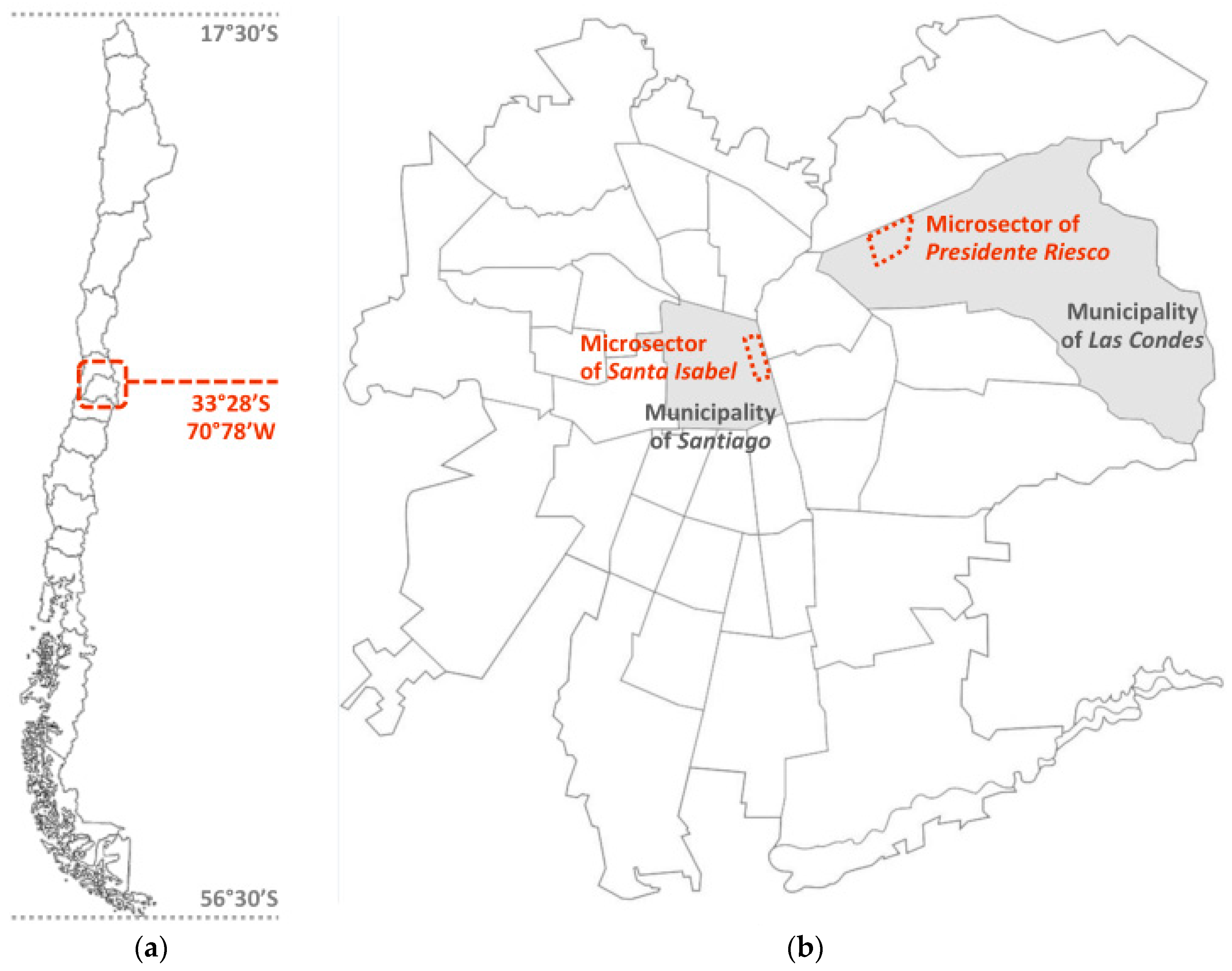




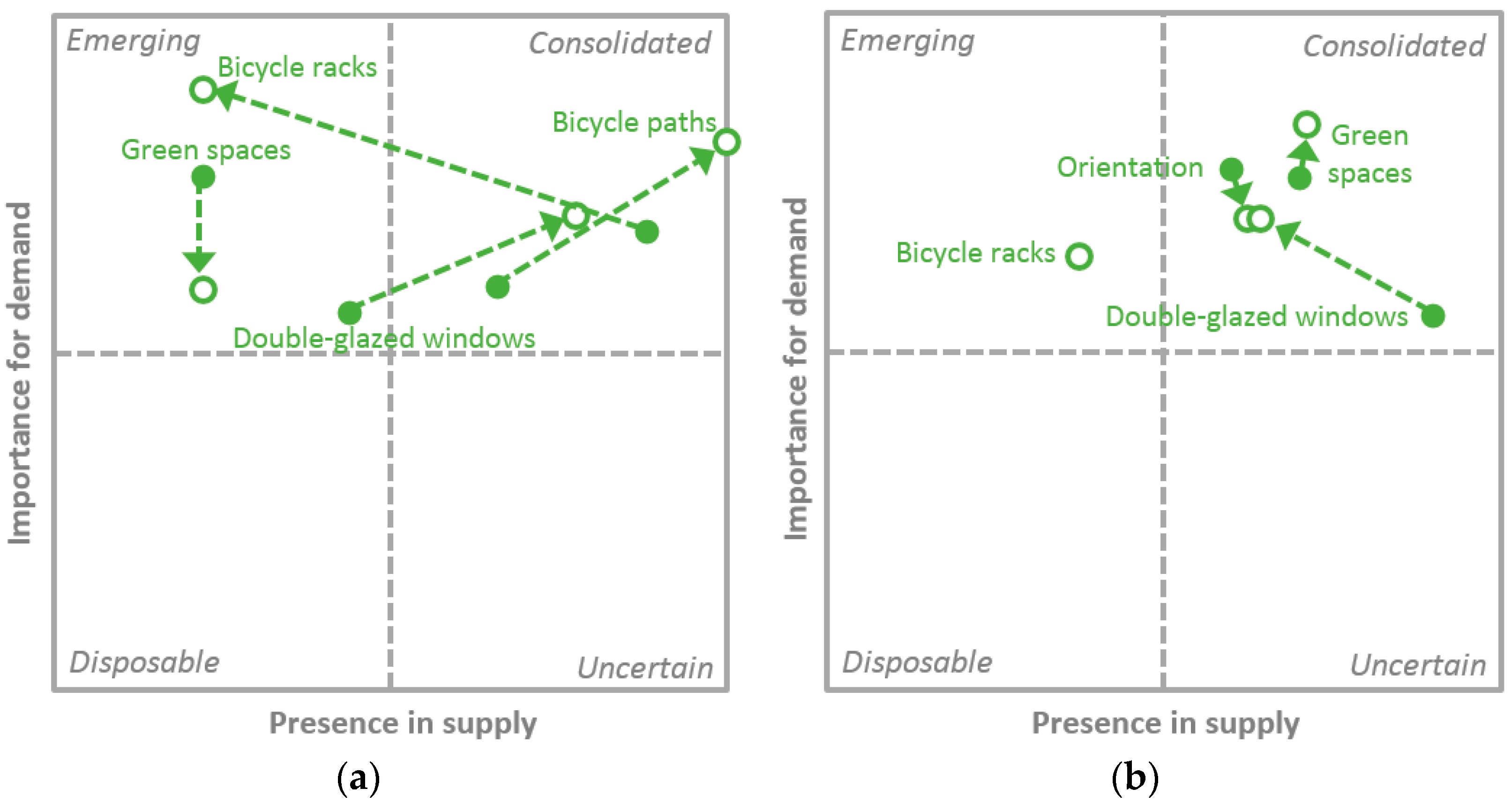
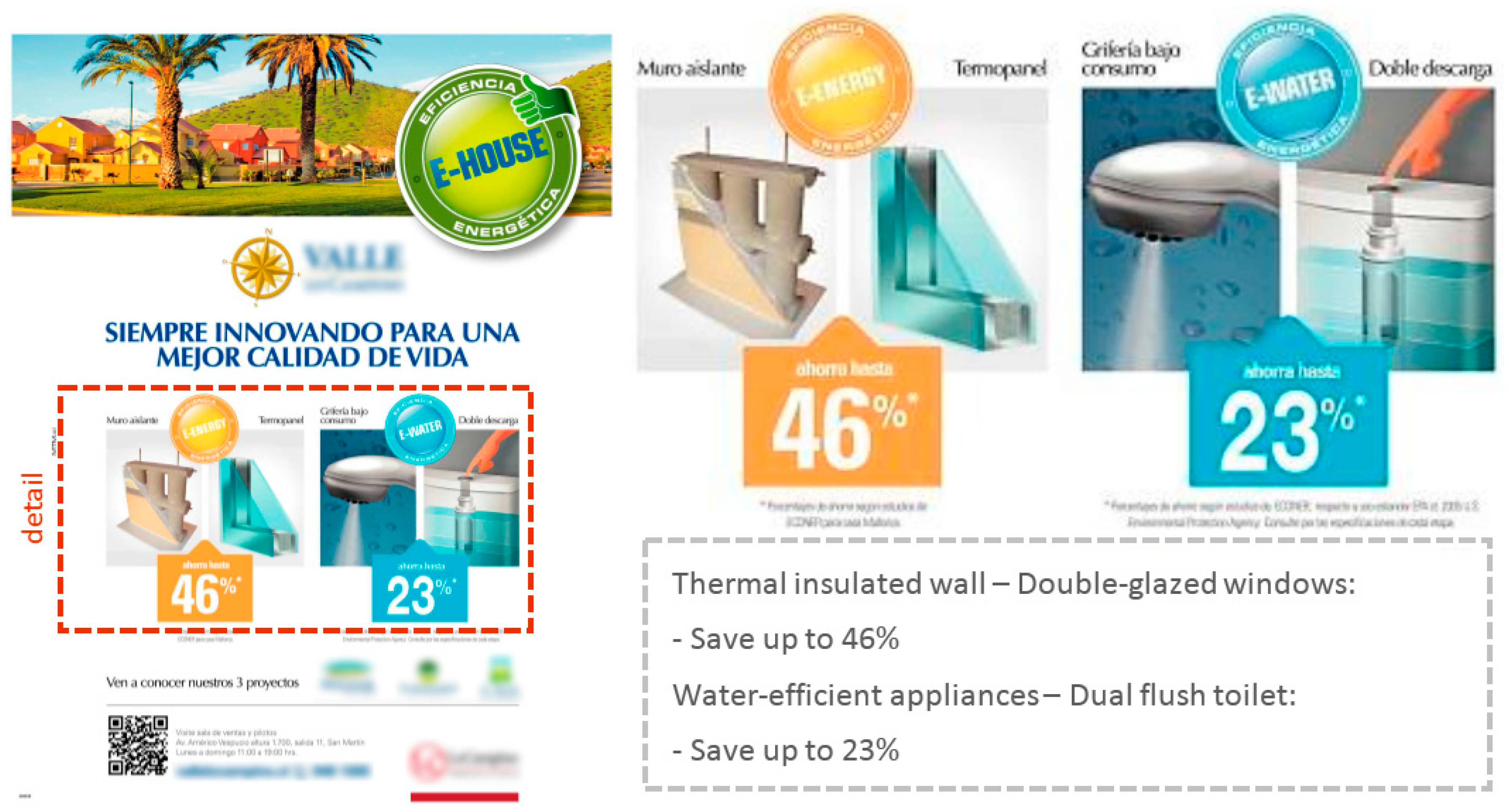
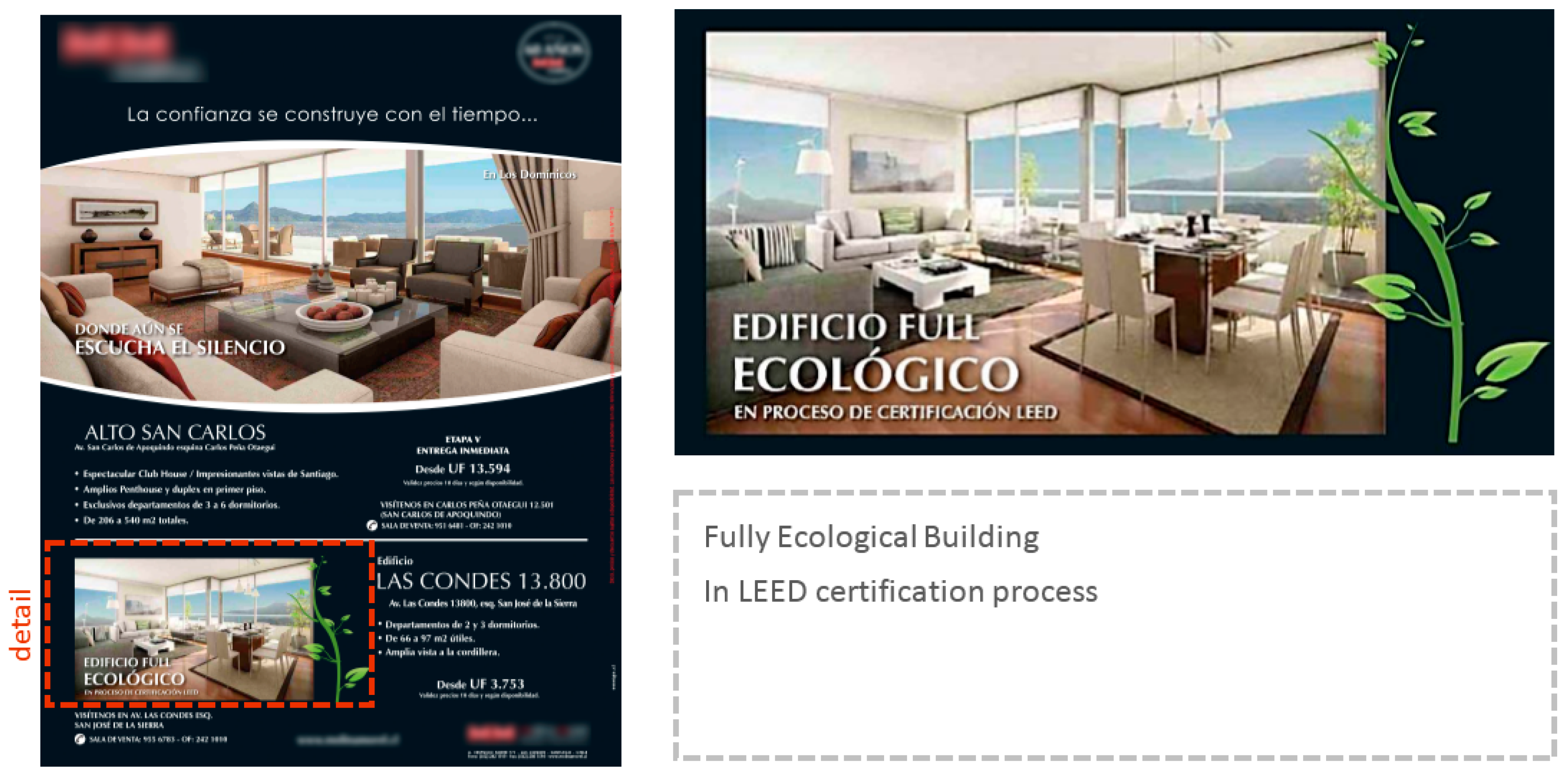

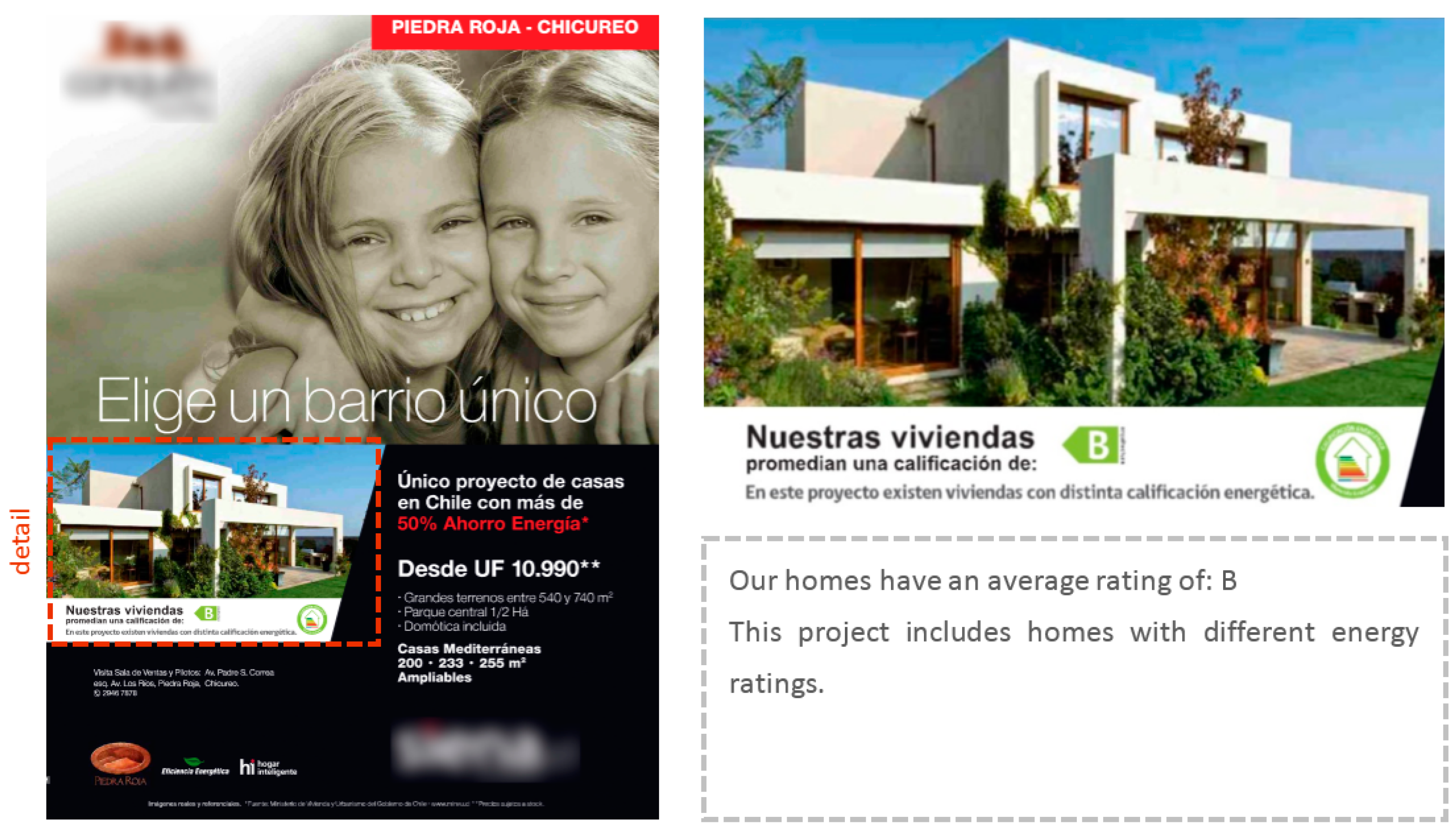

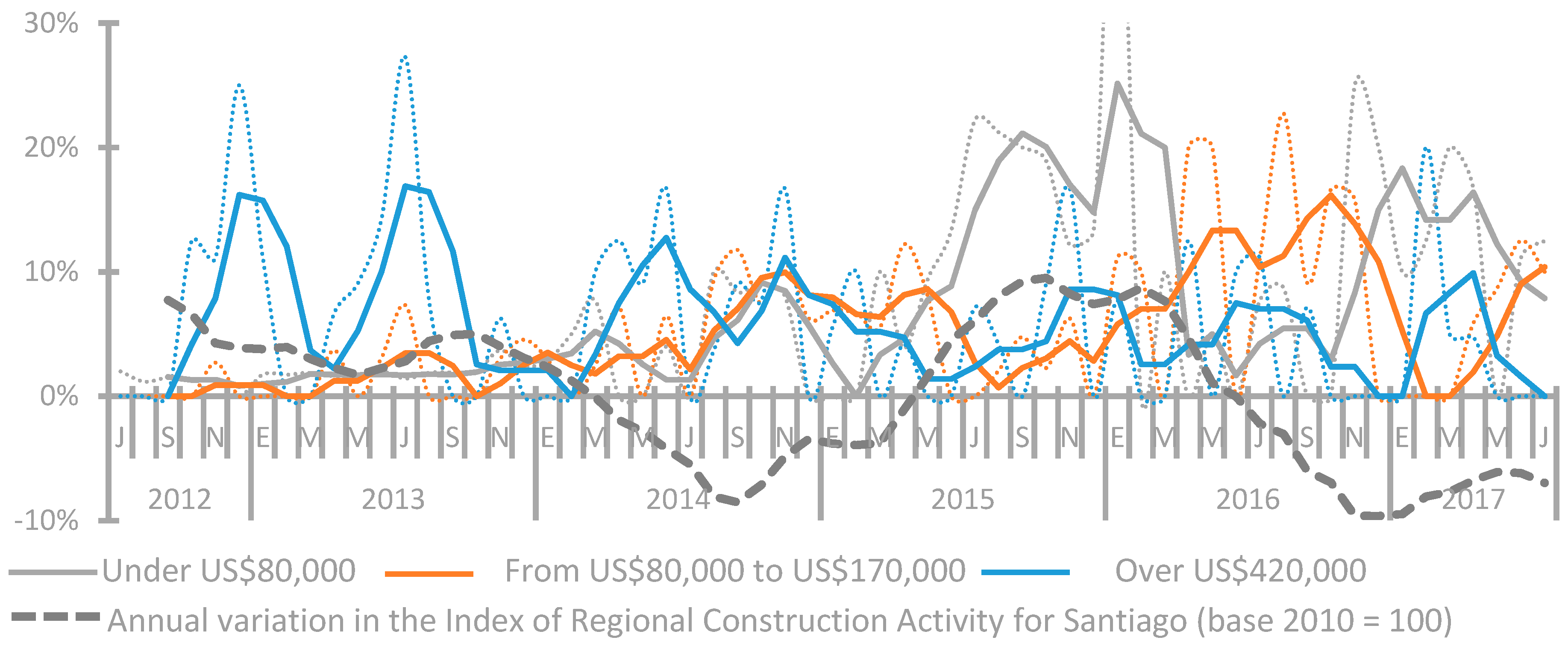
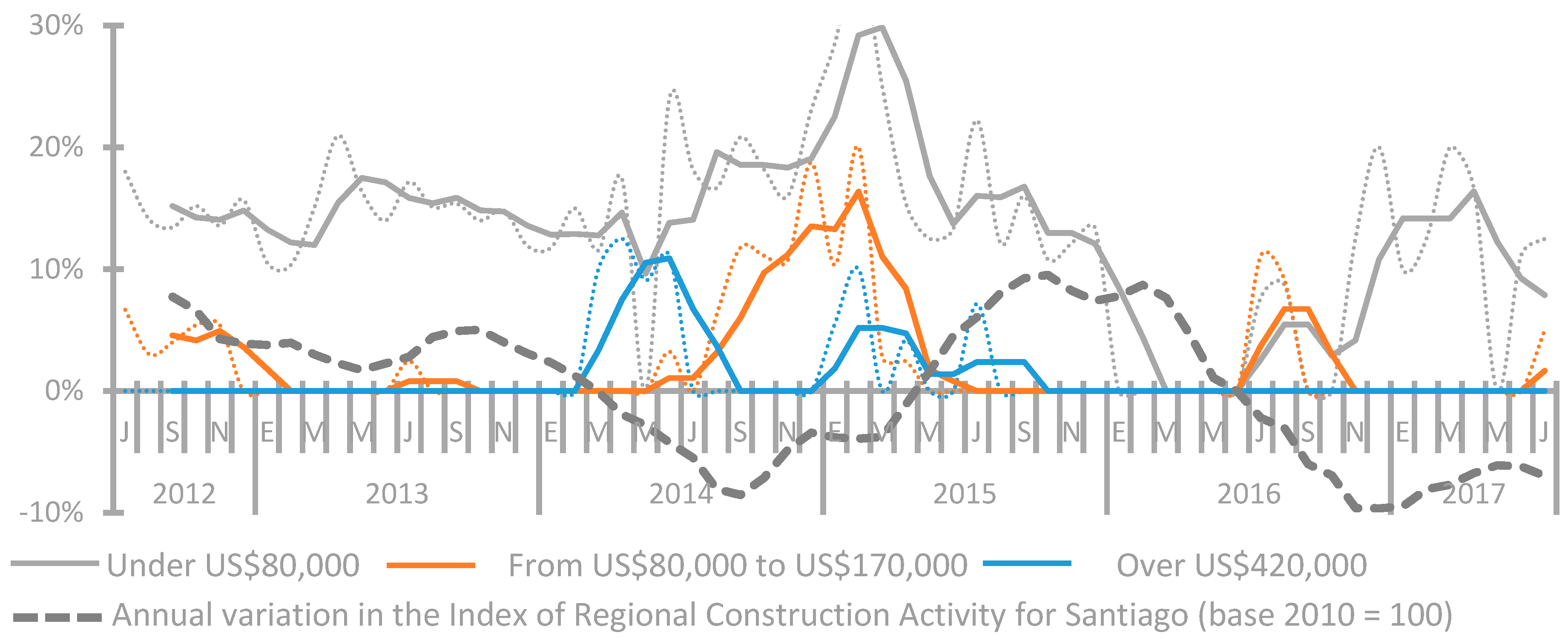

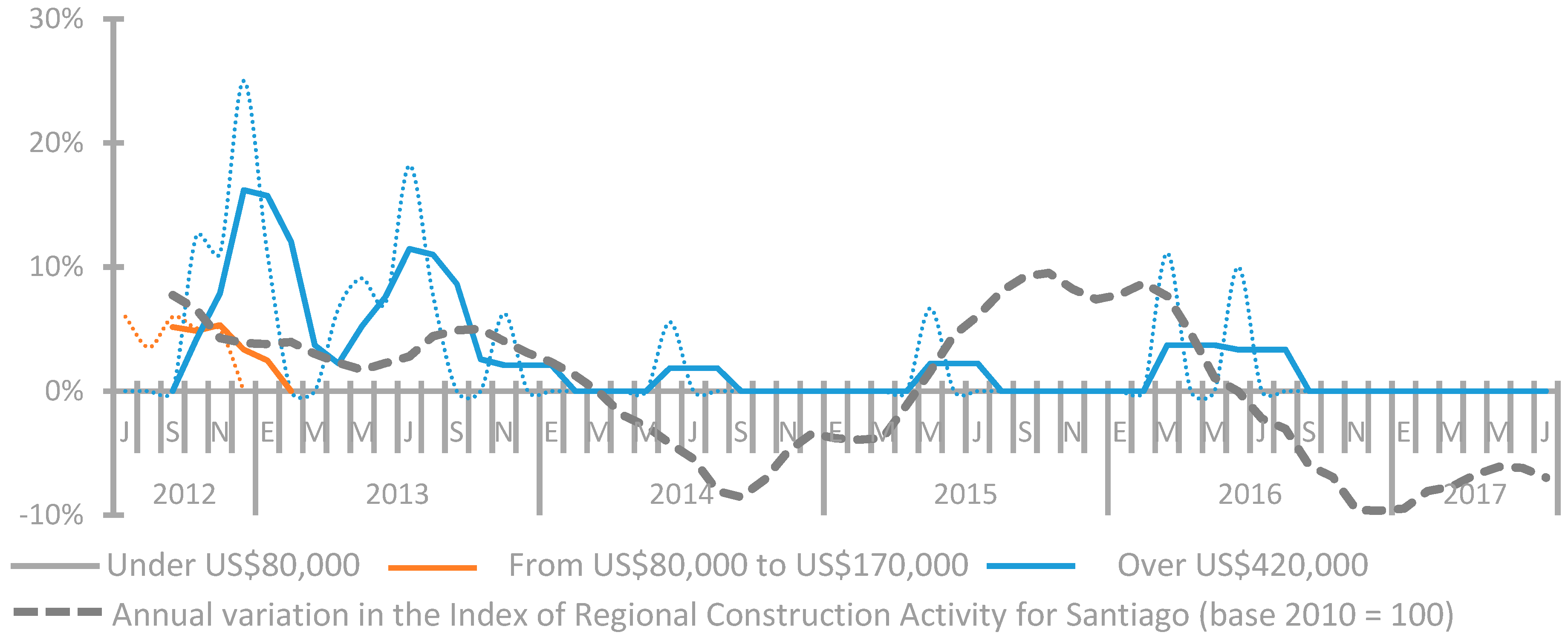
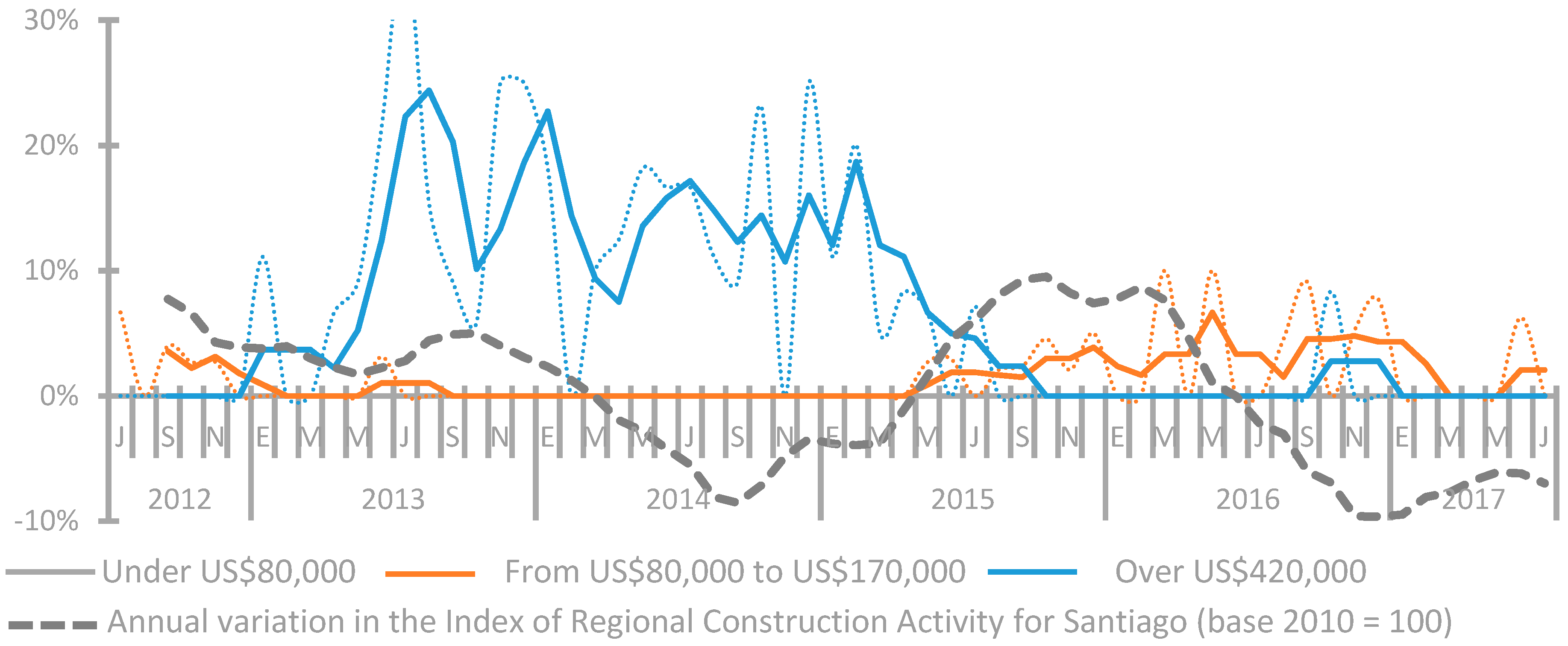
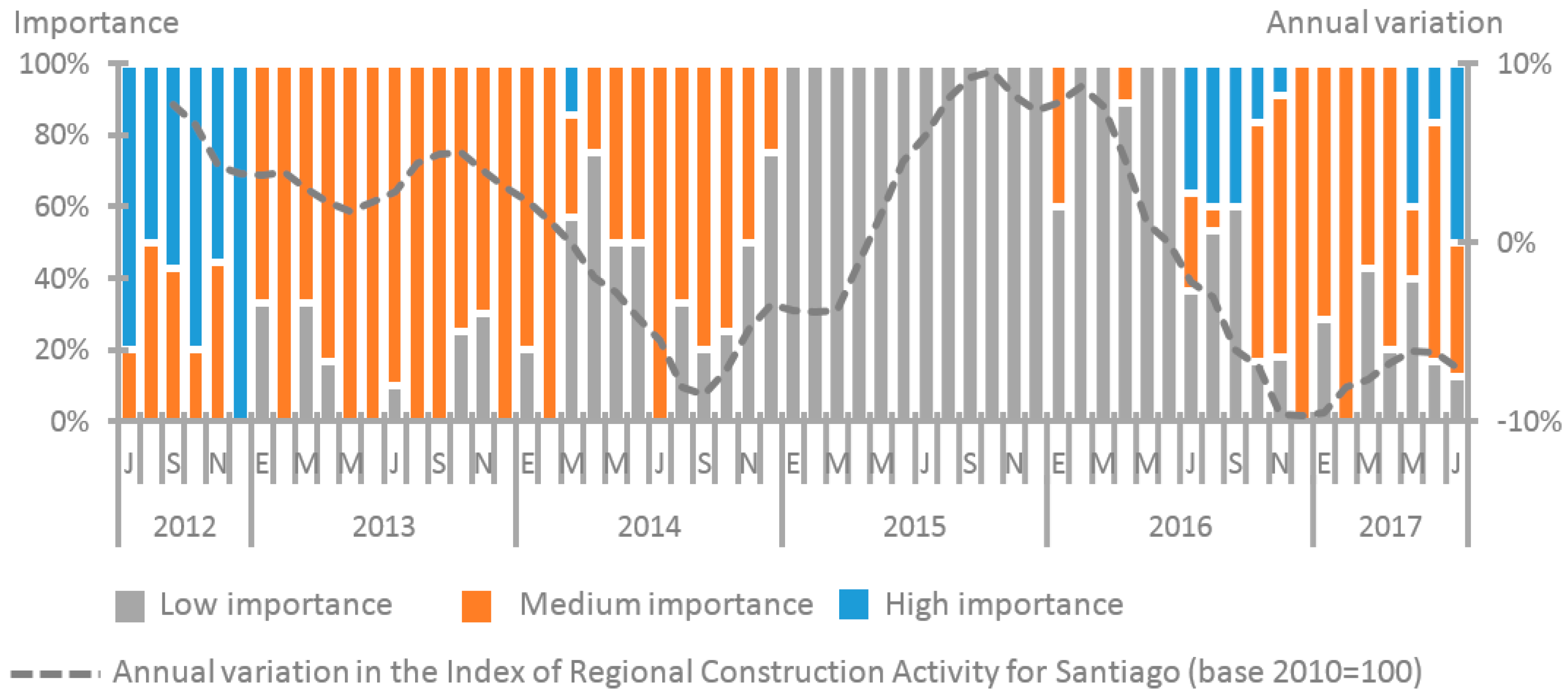



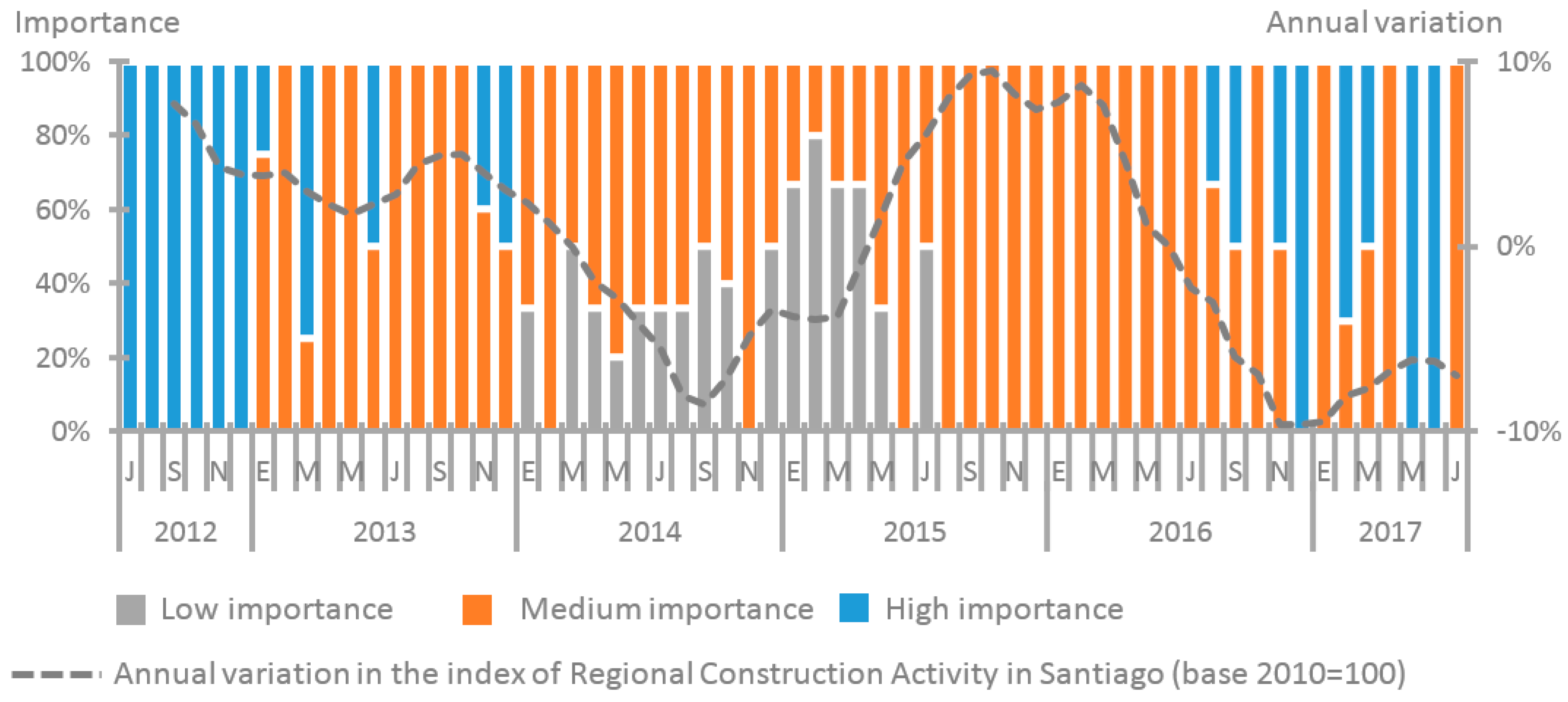
| A and B Ratings | C and D Ratings | E, F and G Ratings | Total | ||||||
|---|---|---|---|---|---|---|---|---|---|
| N | % | N | % | N | % | N | % | ||
| Private housing | Prequalification | 1047 | 95.4% | 1900 | 20.4% | 998 | 12.7% | 3945 | 21.6% |
| Qualification | 94 | 81.0% | 402 | 9.0% | 98 | 1.6% | 594 | 5.5% | |
| Public housing | Prequalification | 50 | 4.6% | 7083 | 75.9% | 6626 | 84.6% | 13,759 | 75.4% |
| Qualification | 22 | 19.0% | 4028 | 90.2% | 5974 | 96.3% | 10,024 | 93.0% | |
| Mixed housing | Prequalification | 1 | 0.1% | 344 | 3.7% | 205 | 2.6% | 550 | 3.0% |
| Qualification | 0 | 0.0% | 34 | 0.8% | 132 | 2.1% | 166 | 1.5% | |
| Total | Prequalification | 1098 | 100.0% | 9327 | 100.0% | 7829 | 100.0% | 18,254 | 100.0% |
| Qualification | 116 | 100.0% | 4464 | 100.0% | 6204 | 100.0% | 10,784 | 100.0% | |
| Energy Efficient | Sustainable | ||||
|---|---|---|---|---|---|
| No | Yes | No | Yes | ||
| Double-glazed windows | No | 95.2% | 76.6% | 94.4% | 98.8% |
| Yes | 4.8% | 23.4% | 5.6% | 1.2% | |
| Total | 100.0% | 100.0% | 100.0% | 100.0% | |
| Solar thermal collectors | No | 95.9% | 73.7% | 95.2% | 81.8% |
| Yes | 4.1% | 26.3% | 4.8% | 18.2% | |
| Total | 100.0% | 100.0% | 100.0% | 100.0% | |
| Energy certification | No | 99.2% | 74.9% | 98.6% | 81.8% |
| Yes | 0.8% | 25.1% | 1.4% | 18.2% | |
| Total | 100.0% | 100.0% | 100.0% | 100.0% | |
| Water-efficient appliances | No | 99.4% | 78.6% | 98.8% | 86.7% |
| Yes | 0.6% | 21.4% | 1.2% | 13.3% | |
| Total | 100.0% | 100.0% | 100.0% | 100.0% | |
| EIFS-type thermal insulation 1 | No | 99.6% | 92.5% | 99.3% | 100.0% |
| Yes | 0.4% | 7.5% | 0.7% | 0.0% | |
| Total | 100.0% | 100.0% | 100.0% | 100.0% | |
© 2018 by the authors. Licensee MDPI, Basel, Switzerland. This article is an open access article distributed under the terms and conditions of the Creative Commons Attribution (CC BY) license (http://creativecommons.org/licenses/by/4.0/).
Share and Cite
Encinas, F.; Aguirre, C.; Marmolejo-Duarte, C. Sustainability Attributes in Real Estate Development: Private Perspectives on Advancing Energy Regulation in a Liberalized Market. Sustainability 2018, 10, 146. https://doi.org/10.3390/su10010146
Encinas F, Aguirre C, Marmolejo-Duarte C. Sustainability Attributes in Real Estate Development: Private Perspectives on Advancing Energy Regulation in a Liberalized Market. Sustainability. 2018; 10(1):146. https://doi.org/10.3390/su10010146
Chicago/Turabian StyleEncinas, Felipe, Carlos Aguirre, and Carlos Marmolejo-Duarte. 2018. "Sustainability Attributes in Real Estate Development: Private Perspectives on Advancing Energy Regulation in a Liberalized Market" Sustainability 10, no. 1: 146. https://doi.org/10.3390/su10010146







